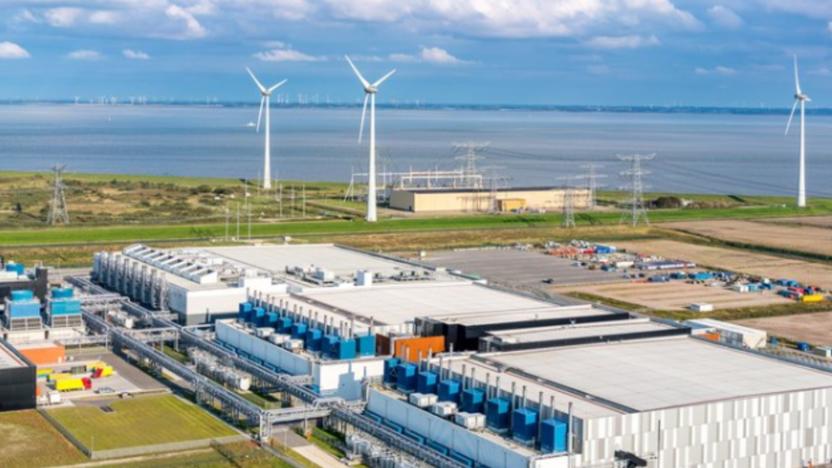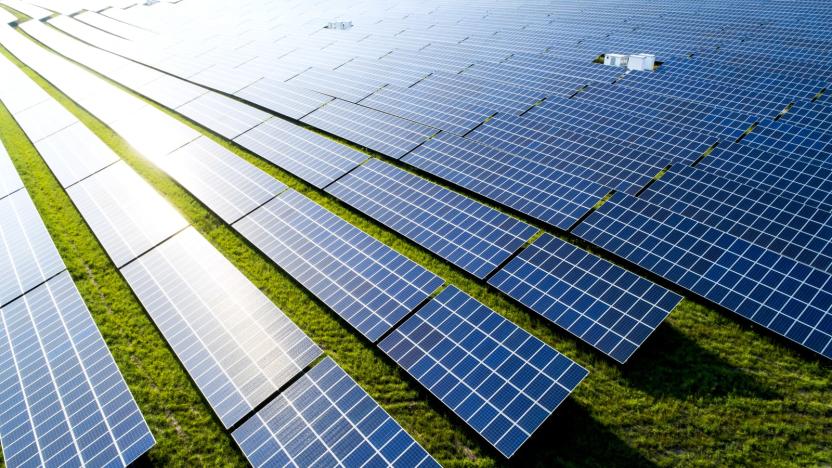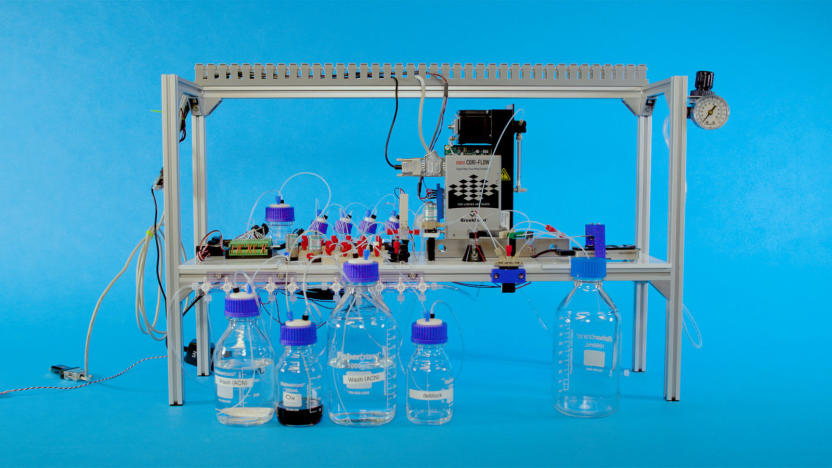data centers
Latest

Google says it offset all of the emissions it has ever generated
Google eliminates its 'entire carbon legacy' and plans to use only clean energy by 2030.

Google's data centers will process some tasks when clean energy is abundant
Google's new carbon-intelligent computing platform will optimize how its data centers handle tasks to take advantage of solar and wind energy.

The rise of cloud computing has had a smaller climate impact than feared
As more and more gargantuan data centers come on line, environmentalists have been concerned about massive increases in electricity consumption and pollution. However, according to a new study published in Science, that simply hasn't happened. While cloud computing output has jumped by 600 percent from 2010 to 2018, energy consumption rose by just 6 percent. That's because companies like Google have massively increased efficiencies with new chip designs, custom-tailored airflow solutions and other tech.

Amazon plans new solar and wind farms in Ireland and Virginia
Months after Amazon shareholders turned down a plea by employees to do more about climate change, the company announced two new renewable energy projects. Today, Amazon shared plans for a wind farm in Ireland and a solar farm in Pittsylvania County, Virginia. When completed sometime in 2020, these projects are expected to generate a combined 168,000 MWh of clean energy annually, helping Amazon reach its goal to power 100 percent of its operations with renewable power.

Microsoft device stores digital info as DNA
Microsoft is on its way to replacing data centers with DNA. The company and researchers from the University of Washington have successfully automated the process to translate digital information into DNA and back to bits. They now have the first, full end-to-end automated DNA storage device. And while there's room for improvement, Microsoft hopes this proof-of-concept will advance DNA storage technology.

The TUAW Daily Update Podcast for April 21, 2014
It's the TUAW Daily Update, your source for Apple news in a convenient audio format. You'll get some the top Apple stories of the day in three to five minutes for a quick review of what's happening in the Apple world. You can listen to today's Apple stories by clicking the player at the top of the page. The Daily Update has been moved to a new podcast host in the past few days. Current listeners should delete the old podcast subscription and subscribe to the new feed in the iTunes Store here.

Apple's data centers now powered by 100% renewable energy
Apple released the 2012 update of its environmental policy pages and notes that the company is now using 100 percent renewable energy sources -- solar, wind, hydro and geothermal -- at its data centers. The 100 percent renewable energy figure was also achieved at facilities in Austin, Texas; Elk Grove, Calif.; Cork, Ireland and Munich, Germany, as well as at the Infinite Loop campus in Cupertino, Calif. For all of Apple's corporate facilities worldwide, the figure is at 75 percent, and the company says that they "won't stop working until we achieve 100 percent throughout Apple." The company made a commitment to using 100 percent renewable energy at its data centers in 2012 after being criticized by Greenpeace over its energy usage. As the Apple video below demonstrates, the scope of the photovoltaic arrays used at the Maiden, N.C., data center is breathtaking. [via Bloomberg]

Researchers turn to 19th century math for wireless data center breakthrough
Researchers from Microsoft and Cornell University want to remove the tangles of cables from data centers. It's no small feat. With thousands of machines that need every bit of bandwidth available WiFi certainly isn't an option. To solve the issue, scientists are turning to two sources: the cutting edge of 60GHz networking and the 19th century mathematical theories of Arthur Cayley. Cayley's 1889 paper, On the Theory of Groups, was used to guide their method for connecting servers in the most efficient and fault tolerant way possible. The findings will be presented in a paper later this month, but it won't be clear how effectively this research can be applied to an actual data center until someone funds a prototype. The proposed Cayley data centers would rely on cylindrical server racks that have transceivers both inside and outside the tubes of machines, allowing them to pass data both among and between racks with (hopefully) minimal interference. Since the new design would do away with traditional network switches and cables, researchers believe they may eventually cost less than current designs and will draw less power. And will do so while still streaming data at 10 gigabits per second -- far faster than WiGig, which also makes use of 60GHz spectrum. To read the paper in its entirety check out the source.

Facebook releases its 2011 energy usage report, details your carbon footprint
More Facebook news, but this time we're back to the numbers instead of reporting on a new feature, improvement or integration. As part of its mission to swap the familiar blue for something of a greener tinge, Facebook released today its carbon footprint and overall energy usage figures for 2011. Turning bio-babble into easy visualizations, the company points out that for the whole year, an active user occupied roughly the same carbon footprint as one medium latte. Or, if you're a fan of the tipple, a couple of glasses of wine. Impressively, 23 percent of the social giant's energy usage came from clean and renewable sources, which puts it well on the way to its 2015 target of 25 percent or more. If you'd like more info and a complete breakdown of the stats, the full report is available at the source link below.

Apple breaks ground on second solar farm for North Carolina data center
Last February, Apple came clean about its efforts to clean up the environment, detailing intentions to make its Maiden, NC data facility a greener place. That site, already home to one solar farm, is now set to host a second 20 megawatt photovoltaic array spanning 100 acres, a one-two power punch that'll jointly generate 84 million kWh annually. Combined with the company's in-development biofuel cell plant, scheduled for opening later this year, that theoretic yield should hit the 124 million kWh mark -- an amount sufficient to power nearly 11,000 households -- providing 60 percent of the center's electric demands. Still, that's not enough to adequately keep operations afloat, so for that very necessary, leftover 40 percent, the house that Jobs built plans to purchase similar clean energy from outside local sources. When all is finally up and running smoothly, the southern facility will earn the distinction of "most environmentally sound data center ever built." Or, at least until another well-heeled competitor comes along to contest that title. Now that's a friendly competition we can get behind.

Facebook's Open Compute takes on data storage, designs a better home for your photos
Facebook wasn't kidding when it said it wanted to build better backends for the digital world -- after sharing the plans for its customized data center, it's looking to do the same with storage hardware. "We're taking the same approach we took with servers," Frank Frankovsky, Facebook's director of Hardware Design, told Wired. "Eliminate anything that's not directly adding value." Frankovsky says they are working on a completely tool-less design, eliminating the need for mounting screws and plastic handles on hot-plug driver carriers. The goal is to get the outfit's new storage digs to run as efficiently as its previous efforts, streamlining hardware to be more serviceable, cost less and use less energy. The new storage designs are set to debut at the Open Compute Summit in early May, and hopes that sharing the designs will help redefine how storage hardware is made. Check out the source link below for Wired's in-depth look at the project.[Photo credit: Jon Snyder/Wired.com]

Apple's 2012 environmental report reveals giant solar array
Apple just released its 2012 environmental report, detailing all the ways it's conserving energy and working to make Mother Earth a slightly cleaner place. A highlight of that effort is clearly the company's data center in Maiden, North Carolina. The giant white-roofed server bunker will soon be home to the largest end user-owned solar array in the US -- covering 100 acres and producing 42 million kWh of electricity each year. The 20-megawatt installation is only the beginning too. A five-megawatt fuel cell facility will soon be going up alongside it. Hit up the source link for the full report, but be forewarned, it comes only in PDF format.

Report: data centers accounted for just 1 to 1.5 percent of electricity use last year, Google claims less than 1 percent of that
You'd think, watching companies like Apple break ground on sprawling data centers, that the number of servers powering our untethered lives was on the rise. In a different decade, you might have been right. But not this one. According to a study prepared at the request of The New York Times, the number of servers in use has declined "significantly" since 2005. That's mostly because of the financial crisis of 2008, says lead researcher Jonathan G. Koomey of Stanford University, but we also can't discount the effect of more efficient technologies. What's more, he says, servers worldwide consume less energy than you might have guessed: they accounted for somewhere between 1 and 1.5 percent of global electricity use in 2010. And while Google, the king of cloud computing, has been cagey about revealing just how many servers house its treasure trove of data, the company said that of that 1 to 1.5 percent, it accounted for less than 1 percent -- meaning, just a hundredth of a percent of all the electricity consumed last year. All told, data centers' energy consumption has risen 56 percent since 2005 -- a far cry from the EPAs 2007 prediction that this figure would double by 2010, with annual costs ballooning to $7.4 billion. Then again, this slower-than-expected growth could well be temporary. Though Koomey can't specify to what extent the financial crisis and technological advancements are to blame, he insists, broadly speaking, that we're primarily seeing fallout from the economic slowdown -- a stay of execution, of sorts, for those of us rooting for energy conservation.

Visualized: ring around the world of data center power usage
Facebook may have recently boasted about how energy efficient its data centers are, but it is still Facebook, and that means it consumes plenty of power regardless -- more than anyone else, in fact, according to Peer1's recent survey of the world's most visited websites. As you can see above, that bit of data has also been conveniently visualized by the company in a colorful chart (with a noticeable lack of green), and there's plenty more details where that came from for you to dive into in the infographic linked below.

Google signs 20-year deal to power data centers with wind energy
It's not the first investment Google has made in wind power, but anyone wondering about its commitment needn't look any further than the company's just-announced deal with NextEra Energy. It's agreed to buy wind power from NextEra's wind farm in Iowa for the next twenty years, which it says will provide enough power to supply "several" of its data centers. What's more, Google says that the size and length of the deal (taking 114 megawatts of energy off the market) will also lead to other indirect benefits for the wind power industry, and give NextEra the flexibility to invest in additional clean energy projects. Head on past the break for NextEra's press release on the deal.

Dave Perry details Gaikai's server plan, teases E3 announcement
Dave Perry is dreaming big with his Gaikai streaming service. He went into a little more detail on just how it will at work at today's LA Games Conference. The company is still planning to kick off its service with 300 data centers, and while he admits it will have "much more traffic than the servers can handle," Gaikai will limit early users to those closest to the centers. If you're close enough to the server to have only about 5-10 milliseconds of lag, you'll get in. If not, Perry told Joystiq, then you won't even see the embedded window -- but your request will be logged anyway. That way, he said, Gaikai will be able to track not just where people are using the service, but where they want to use it. If a bunch of users in Alaska try to play, but can't connect because they're too far away, then "we know we're losing money in Alaska," he says, and Gaikai will set up more datacenters there. Perry says Gaikai will help with security as well -- he suggested that companies might even be able to release their E3 demos to the world just during the week of the event, allowing press or the public to play them online for a limited time, with the code securely held on Gaikai's servers. It's all speculation at this point, though -- a service like that won't be ready to go by this year's E3 in June. But stay tuned anyway: Perry also promised us an announcement about Gaikai at E3. "We got some cool stuff to show off," he confirmed with a knowing nod.

Behind the scenes of WoW's bandwidth
We heard a little while back that it was AT&T who provide data center hosting to Blizzard and this gigantic game (and actually, we've had outage problems before due to maintenance on AT&T's end), but our friend Tamara Chuang of the Orange County Register went straight to the source, and spoke with the big bandwidth provider on just what it takes to keep the servers up. There's some good information in there, especially if you're interested in all of the motherboards and wires that run the World of Warcraft. MMOs are apparently AT&T's biggest gaming customers, and they run the wires for companies like Blizzard as well as Konami and Turbine. They originally helped run Battle.net, and when Blizzard wanted to expand with World of Warcraft, AT&T's gaming division expanded with them.Unfortunately, there's a lot of secrets here -- given that they're selling a service, AT&T doesn't speak too frankly about how much downtime they're really responsible for, and of course as a trade secret they can't give any numbers on how much bandwidth is passing through and where it's all going. But they will say that they've got latency levels down to milliseconds (in their testing, I'm sure -- lots of players would probably suggest it's a little worse, depending on which ISP you use), and that they offer services like Synaptic Hosting. During times of hard usage, Blizzard can ask (for a price, of course) to open the floodgates up and make sure there's enough bandwidth to go around.










